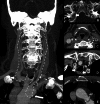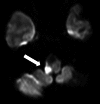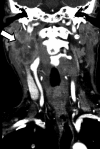Vocal cord paralysis: anatomy, imaging and pathology
- PMID: 25315036
- PMCID: PMC4263806
- DOI: 10.1007/s13244-014-0364-y
Vocal cord paralysis: anatomy, imaging and pathology
Abstract
Vocal cord paralysis (VCP) can be caused by any process that interferes with the normal function of the vagal nerves or recurrent laryngeal nerves. It may be a first sign of extensive and severe pathology. Radiologists must therefore be able to recognise the imaging findings of VCP and know the course of the vagal and recurrent laryngeal nerves. This review focuses on the anatomy and imaging evaluation of these nerves and thereby the possible sites for pathology causing VCP. The imaging characteristics and imaging mimics of VCP are discussed and cases from daily practice illustrating causes of VCP are presented.
Teaching points: • Vocal cord paralysis may be the first presentation of severe pathology. • Radiologists must be aware of imaging characteristics and mimics of vocal cord paralysis. • Lesions along the vagal nerves and recurrent laryngeal nerves can cause vocal cord paralysis.
Figures
















References
-
- Rosenthal LH, Benninger MS et al (2007) Vocal fold immobility: a longitudinal analysis of etiology over 20 years. Laryngoscope 117:1864–1870 - PubMed
-
- Richardson BE, Bastian RW (2004) Clinical evaluation of vocal fold paralysis. Otolaryngol Clin North Am 37:45–58 - PubMed
-
- Myssiorek D (2004) Recurrent laryngeal nerve paralysis: anatomy and etiology. Otolaryngol Clin North Am 37:25–44 - PubMed
-
- ten Donkelaar HJ (2007) Klinische Anatomie en Embryologie. Reed Business, Amsterdam. ISBN: 9789035229013
LinkOut - more resources
Full Text Sources
Other Literature Sources
Miscellaneous

